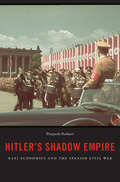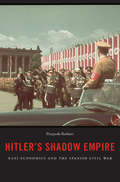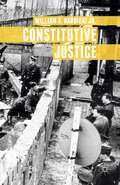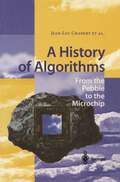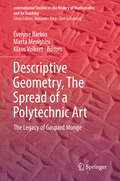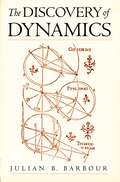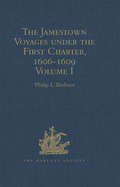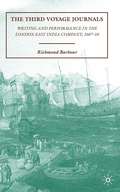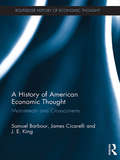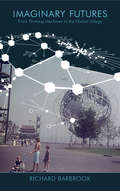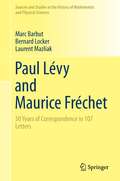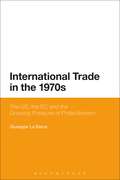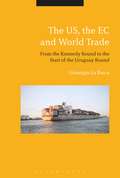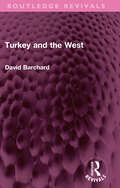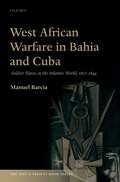- Table View
- List View
Hitler's Shadow Empire: The Nazis And The Spanish Civil War
by Pierpaolo BarbieriThe Nazis provided Franco’s Nationalists with planes, armaments, and tanks in their civil war against the Communists but behind this largesse was a Faustian bargain. Pierpaolo Barbieri makes a convincing case that the Nazis hoped to establish an economic empire in Europe, and in Spain they tested the tactics intended for future subject territories.
Hitler's Shadow Empire: The Nazis And The Spanish Civil War
by Pierpaolo BarbieriThe Nazis provided Franco’s Nationalists with planes, armaments, and tanks in their civil war against the Communists but behind this largesse was a Faustian bargain. Pierpaolo Barbieri makes a convincing case that the Nazis hoped to establish an economic empire in Europe, and in Spain they tested the tactics intended for future subject territories.
Constitutive Justice
by William A. BarbieriBoth classical and modern accounts of justice largely overlook the question of how the communities within which justice applies are constituted in the first place. This book addresses that problem, arguing that we need to accord a place to the theory of 'constitutive justice' alongside traditional categories of distributive and commutative justice.
A History of Algorithms: From the Pebble to the Microchip
by E. Barbin J. Borowczyk J. L. Chabert M. Guillemot A. Michel-Pajus A. Djebbar J. C. MartzloffThe development of computing has reawakened interest in algorithms. Often neglected by historians and modern scientists, algorithmic procedures have been instrumental in the development of fundamental ideas: practice led to theory just as much as the other way round. The purpose of this book is to offer a historical background to contemporary algorithmic practice.
Descriptive Geometry, The Spread of a Polytechnic Art: The Legacy of Gaspard Monge (International Studies in the History of Mathematics and its Teaching)
by Évelyne Barbin Marta Menghini Klaus VolkertThis book seeks to explore the history of descriptive geometry in relation to its circulation in the 19th century, which had been favoured by the transfers of the model of the École Polytechnique to other countries. The book also covers the diffusion of its teaching from higher instruction to technical and secondary teaching. In relation to that, there is analysis of the role of the institution – similar but definitely not identical in the different countries – in the field under consideration. The book contains chapters focused on different countries, areas, and institutions, written by specialists of the history of the field. Insights on descriptive geometry are provided in the context of the mathematical aspect, the aspect of teaching in particular to non-mathematicians, and the institutions themselves.
Ottoman Rule in Damascus, 1708-1758
by Karl K. BarbirOn the basis of new evidence from the Ottoman archives in Istanbul, Karl Barbir challenges the current interpretation of Ottoman rule in Damascus during the eighteenth century. He argues that the prevailing themes of decline and stagnation--usually applied to the entire century--in fact apply only to the latter half of the century. This discovery, he contends, affords a more balanced and realistic view of the Near East's Ottoman past than previous studies have suggested.Originally published in 1980.The Princeton Legacy Library uses the latest print-on-demand technology to again make available previously out-of-print books from the distinguished backlist of Princeton University Press. These editions preserve the original texts of these important books while presenting them in durable paperback and hardcover editions. The goal of the Princeton Legacy Library is to vastly increase access to the rich scholarly heritage found in the thousands of books published by Princeton University Press since its founding in 1905.
The Discovery of Dynamics: A Study from a Machian Point of View of the Discovery and the Structure of Dynamical Theories
by Julian B. BarbourEver since Newton created dynamics, there has been controversy about its foundations. Are space and time absolute? Do they form a rigid but invisible framework and container of the universe? Or are space, time, and motion relative? If so, does Newton's 'framework' arise through the influence of the universe at large, as Ernst Mach suggested? Einstein's aim when creating his general theory of relativity was to demonstrate this and thereby implement 'Mach's Principle'. However, it is widely believed that he achieved only partial success. This question of whether motion is absolute or relative has been a central issues in philosophy; the nature of time has perennial interest. Current attempts to create a quantum description of the whole universe keep these issues at the cutting edge of modern research. Written by the world's leading expert on Mach's Principle, The Discovery of Dynamics is a highly original account of the development of notions about space, time, and motion. Widely praised in its hardback version, it is one of the fullest and most readable accounts of the astronomical studies that culminated in Kepler's laws of planetary motion and of the creation of dynamics by Galileo, Descartes, Huygens, and Newton. Originally published as Absolute or Relative Motion?, Vol. 1: The Discovery of Dynamics (Cambridge), The Discovery of Dynamics provides the technical background to Barbour's recently published The End of Time, in which he argues that time disappears from the description of the quantum universe.
The Complete Works of Captain John Smith, 1580-1631, Volume I: Volume I (Published by the Omohundro Institute of Early American History and Culture and the University of North Carolina Press #1)
by Philip L. BarbourEdited by the late Philip L. Barbour, acknowledged as the leading authority on Captain John Smith, this annotated three-volume work is the only modern edition of the works of the legendary figure who captured the interest of scholars and general readers for over four centuries. A hero and adventurer, Smith was the leader who saved Jamestown from self-destruction, and he was also instrumental in the exploration and settlement of New England. He produced one of the basic ethnological studies of the tide-water Algonkians, an invaluable contemporary history of early Virginia, the earliest well-defined maps of Chesapeake Bay and the New England coast, and the first printed dictionary of English nautical terms. This is Volume I of three volumes.Originally published in 2011.A UNC Press Enduring Edition -- UNC Press Enduring Editions use the latest in digital technology to make available again books from our distinguished backlist that were previously out of print. These editions are published unaltered from the original, and are presented in affordable paperback formats, bringing readers both historical and cultural value.
The Complete Works of Captain John Smith, 1580-1631, Volume II: Volume II (Published by the Omohundro Institute of Early American History and Culture and the University of North Carolina Press #2)
by Philip L. BarbourEdited by the late Philip L. Barbour, acknowledged as the leading authority on Captain John Smith, this annotated three-volume work is the only modern edition of the works of the legendary figure who captured the interest of scholars and general readers for over four centuries. A hero and adventurer, Smith was the leader who saved Jamestown from self-destruction, and he was also instrumental in the exploration and settlement of New England. He produced one of the basic ethnological studies of the tide-water Algonkians, an invaluable contemporary history of early Virginia, the earliest well-defined maps of Chesapeake Bay and the New England coast, and the first printed dictionary of English nautical terms. This is Volume II of three volumes.Originally published in 2011.A UNC Press Enduring Edition -- UNC Press Enduring Editions use the latest in digital technology to make available again books from our distinguished backlist that were previously out of print. These editions are published unaltered from the original, and are presented in affordable paperback formats, bringing readers both historical and cultural value.
The Complete Works of Captain John Smith, 1580-1631, Volume III: Volume III (Published by the Omohundro Institute of Early American History and Culture and the University of North Carolina Press #3)
by Philip L. BarbourEdited by the late Philip L. Barbour, acknowledged as the leading authority on Captain John Smith, this annotated three-volume work is the only modern edition of the works of the legendary figure who captured the interest of scholars and general readers for over four centuries. A hero and adventurer, Smith was the leader who saved Jamestown from self-destruction, and he was also instrumental in the exploration and settlement of New England. He produced one of the basic ethnological studies of the tide-water Algonkians, an invaluable contemporary history of early Virginia, the earliest well-defined maps of Chesapeake Bay and the New England coast, and the first printed dictionary of English nautical terms. This is Volume III of three volumes.Originally published in 2011.A UNC Press Enduring Edition -- UNC Press Enduring Editions use the latest in digital technology to make available again books from our distinguished backlist that were previously out of print. These editions are published unaltered from the original, and are presented in affordable paperback formats, bringing readers both historical and cultural value.
The Jamestown Voyages under the First Charter, 1606-1609: Documents relating to the Foundation of Jamestown and the History of the Jamestown Colony up to the Departure of Captain John Smith, last President of the Council in Virginia under the First Charter, early in October, 1609 (Hakluyt Society, Second Series)
by Philip L. BarbourIn December 1606, 120 emigrants left London in three small vessels. They landed nearly five months later in Virginia and founded a settlement which they called Jamestown. Thus the first permanent English colony was established in America. During the first few years, the colony was beset by extreme hardship. The local Indians regarded the settlement as infringement of their territory and were hostile to the settlers. Famine, plague and internal dissension also took their toll. The settlers relied for survival on provisions and men brought from England. The ships travelled the long route by way of the Canaries and the Caribbean and were always in danger of attack by the Spanish. In these 2 volumes Mr Barbour has collected all the known documents relating to the Jamestown voyages during the life of the original charter. He has annotated them and translated those written in languages other than English. In his introduction he reviews the early sources, in particular books about the early history of the colony written by emigrants. This collection gives a graphic and fascinating contemporary picture of the first few years of the colony out of which the United States was destined to grow. Includes a combined list of names of the original planters up to about 1 October 1608. The main pagination of this and the following volume (Second Series 137) is continuous. This is a new print-on-demand hardback edition of the volume first published in 1969.
The Jamestown Voyages under the First Charter, 1606-1609: Documents relating to the Foundation of Jamestown and the History of the Jamestown Colony up to the Departure of Captain John Smith, last President of the Council in Virginia under the First Charter, early in October, 1609 (Hakluyt Society, Second Series #137)
by Philip L. BarbourIn December 1606, 120 emigrants left London in three small vessels. They landed nearly five months later in Virginia and founded a settlement which they called Jamestown. Thus the first permanent English colony was established in America. During the first few years, the colony was beset by extreme hardship. The local Indians regarded the settlement as infringement of their territory and were hostile to the settlers. Famine, plague and internal dissension also took their toll. The settlers relied for survival on provisions and men brought from England. The ships travelled the long route by way of the Canaries and the Caribbean and were always in danger of attack by the Spanish. In these 2 volumes Mr Barbour has collected all the known documents relating to the Jamestown voyages during the life of the original charter. He has annotated them and translated those written in languages other than English. In his introduction he reviews the early sources, in particular books about the early history of the colony written by emigrants. This collection gives a graphic and fascinating contemporary picture of the first few years of the colony out of which the United States was destined to grow. Includes a combined list of names of the original planters up to about 1 October 1608. The main pagination of this and the following volume (Second Series 137) is continuous. This is a new print-on-demand hardback edition of the volume first published in 1969.
The Third Voyage Journals: Writing and Performance in the London East India Company, 1607-10
by R. BarbourThis volume publishes for the first time the collected journals of the East India Company's Third Voyage (1607-10), England's first to reach India, which proved pivotal to England's emergence as a global player.
A History of American Economic Thought: Mainstream and Crosscurrents (The Routledge History of Economic Thought)
by Samuel Barbour James Cicarelli J. E. KingThis vital addition to the Routledge History of Economic Thought series surveys arguably the most important country in the development of economics as we know it today – the United States of America. A History of American Economic Thought is a comprehensive study of American economics as it has evolved over time, with several singularly unique features including: a thorough examination of the economics of American aboriginals prior to 1492; a detailed discussion of American economics as it has developed during the last fifty years; and a generous dose of non-mainstream American economics under the rubrics "Other Voices" and "Crosscurrents." It is far from being a native American community, and numerous social reformers and those with alternative points of view are given as much weight as the established figures who dominate the mainstream of the profession. Generous doses of American economic history are presented where appropriate to give context to the story of American economics as it proceeds through the ages, from seventeenth-century pre-independence into the twentieth-first century packed full of influential figures including John Bates Clark, Thorstein Veblen, Irving Fisher, Paul Samuelson, and John Kenneth Galbraith, to name but a few. This volume has something for everyone interested in the history of economic thought, the nexus of American economic thought and American economic history, the fusion of American economics and philosophy, and the history of science.
A History of American Economic Thought: Mainstream and Crosscurrents (The Routledge History of Economic Thought)
by Samuel Barbour James Cicarelli J. E. KingThis vital addition to the Routledge History of Economic Thought series surveys arguably the most important country in the development of economics as we know it today – the United States of America. A History of American Economic Thought is a comprehensive study of American economics as it has evolved over time, with several singularly unique features including: a thorough examination of the economics of American aboriginals prior to 1492; a detailed discussion of American economics as it has developed during the last fifty years; and a generous dose of non-mainstream American economics under the rubrics "Other Voices" and "Crosscurrents." It is far from being a native American community, and numerous social reformers and those with alternative points of view are given as much weight as the established figures who dominate the mainstream of the profession. Generous doses of American economic history are presented where appropriate to give context to the story of American economics as it proceeds through the ages, from seventeenth-century pre-independence into the twentieth-first century packed full of influential figures including John Bates Clark, Thorstein Veblen, Irving Fisher, Paul Samuelson, and John Kenneth Galbraith, to name but a few. This volume has something for everyone interested in the history of economic thought, the nexus of American economic thought and American economic history, the fusion of American economics and philosophy, and the history of science.
Imaginary Futures: From Thinking Machines to the Global Village
by Richard BarbrookThis book is a history of the future. It shows how our contemporary understanding of the Internet is shaped by visions of the future that were put together in the 1950s and 1960s.*BR**BR*At the height of the Cold War, the Americans invented the only working model of communism in human history: the Internet. Yet, for all of its libertarian potential, the goal of this hi-tech project was geopolitical dominance: the ownership of time was control over the destiny of humanity. The potentially subversive theory of cybernetics was transformed into the military-friendly project of 'artificial intelligence'. Capitalist growth became the fastest route to the 'information society'. The rest of the world was expected to follow America's path into the networked future. *BR**BR*Today, we're still being told that the Internet is creating the information society - and that America today is everywhere else tomorrow. Thankfully, at the beginning of the twenty-first century, the DIY ethic of the Internet shows that people can resist these authoritarian prophecies by shaping information technologies in their own interest. Ultimately, if we don't want the future to be what it used to be, we must invent our own, improved and truly revolutionary future.
Imaginary Futures: From Thinking Machines to the Global Village
by Richard BarbrookThis book is a history of the future. It shows how our contemporary understanding of the Internet is shaped by visions of the future that were put together in the 1950s and 1960s.*BR**BR*At the height of the Cold War, the Americans invented the only working model of communism in human history: the Internet. Yet, for all of its libertarian potential, the goal of this hi-tech project was geopolitical dominance: the ownership of time was control over the destiny of humanity. The potentially subversive theory of cybernetics was transformed into the military-friendly project of 'artificial intelligence'. Capitalist growth became the fastest route to the 'information society'. The rest of the world was expected to follow America's path into the networked future. *BR**BR*Today, we're still being told that the Internet is creating the information society - and that America today is everywhere else tomorrow. Thankfully, at the beginning of the twenty-first century, the DIY ethic of the Internet shows that people can resist these authoritarian prophecies by shaping information technologies in their own interest. Ultimately, if we don't want the future to be what it used to be, we must invent our own, improved and truly revolutionary future.
Paul Lévy and Maurice Fréchet: 50 Years of Correspondence in 107 Letters (Sources and Studies in the History of Mathematics and Physical Sciences)
by Marc Barbut Bernard Locker Laurent MazliakThe fascinating correspondence between Paul Lévy and Maurice Fréchet spans an extremely active period in French mathematics during the twentieth century. The letters of these two Frenchmen show their vicissitudes of research and passionate enthusiasm for the emerging field of modern probability theory. The letters cover various topics of mathematical importance including academic careers and professional travels, issues concerning students and committees, and the difficulties both mathematicians met to be elected to the Paris Academy of Sciences.The technical questions that occupied Lévy and Fréchet on almost a daily basis are the primary focus of these letters, which are charged with elation, frustration and humour. Their mathematical victories and setbacks unfolded against the dramatic backdrop of the two World Wars and the occupation of France, during which Lévy was obliged to go into hiding. The clear and persistent desire of these mathematicians to continue their work whatever the circumstance testifies to the enlightened spirit of their discipline which was persistent against all odds.The book contains a detailed and comprehensive introduction to the central topics of the correspondence. The original text of the letters is also annotated by numerous footnotes for helpful guidance. Paul Lévy and Maurice Fréchet will be useful to anybody interested in the history of mathematics in the twentieth century and, in particular, the birth of modern probability theory.
International Trade in the 1970s: The US, the EC and the Growing Pressure of Protectionism
by Giuseppe La BarcaThe 1970s marked the end of the years in which the United States was the guarantor of a free world trade order, while Western Europe made efforts to catch up with the economic superpower. In this book, Dr La Barca explains how the trade environment and trade policies in the United States and in the European Community during the 1970s were more complex than frequently acknowledged. In particular, he examines the promotion of greater governmental protection of national industries and the relationship between such tendencies and the negotiations aimed at reducing trade barriers. This analysis shows how the United States and the European Community agreed to pursue their protectionist practices, thereby creating a barrier to serious efforts to enable free trade.
The US, the EC and World Trade: From the Kennedy Round to the Start of the Uruguay Round
by Giuseppe La BarcaThe period between the close of the Kennedy Round and the opening of the Uruguay Round replaced a decade of fast growth in world output and trade - and of prevailing harmony in trade relations across the Atlantic - with twenty years of currency and trade turmoil and strains between the US and the EC. Giuseppe La Barca provides a comprehensive account of these trade developments and the measures adopted by the US and the EC to cope with them; in doing so, he draws a wider picture of international trade policy-making during the period.The aftermath of the Kennedy Round witnessed the undoing of the Bretton Woods regime, but the consequent overheating of the world economy resulted in an acceleration of international trade while settlement in the currency area contributed to the launching of the Tokyo Round negotiations. The first oil shock heralded an unprecedented slump along with a jump in unemployment and inflation rates. The Tokyo Round resulted only in a first step in eliminating non-tariff barriers, leaving contentious issues between the two transatlantic trading partners unsettled. The second oil shock led to growing calls for protectionism and unilateralism particularly in the US, and the Reagan administration pressed for the launch of the Uruguay Round only partially supported by the EC.Providing an in-depth analysis of trade developments involving the two most important economic actors, and placing these developments in a multilateral, international context, this book offers new insights to scholars of economic history and international political economy.
The US, the EC and World Trade: From the Kennedy Round to the Start of the Uruguay Round
by Giuseppe La BarcaThe period between the close of the Kennedy Round and the opening of the Uruguay Round replaced a decade of fast growth in world output and trade - and of prevailing harmony in trade relations across the Atlantic - with twenty years of currency and trade turmoil and strains between the US and the EC. Giuseppe La Barca provides a comprehensive account of these trade developments and the measures adopted by the US and the EC to cope with them; in doing so, he draws a wider picture of international trade policy-making during the period.The aftermath of the Kennedy Round witnessed the undoing of the Bretton Woods regime, but the consequent overheating of the world economy resulted in an acceleration of international trade while settlement in the currency area contributed to the launching of the Tokyo Round negotiations. The first oil shock heralded an unprecedented slump along with a jump in unemployment and inflation rates. The Tokyo Round resulted only in a first step in eliminating non-tariff barriers, leaving contentious issues between the two transatlantic trading partners unsettled. The second oil shock led to growing calls for protectionism and unilateralism particularly in the US, and the Reagan administration pressed for the launch of the Uruguay Round only partially supported by the EC.Providing an in-depth analysis of trade developments involving the two most important economic actors, and placing these developments in a multilateral, international context, this book offers new insights to scholars of economic history and international political economy.
The Goldsmith's Secret
by Elia Barceló4 A.M. End of December . . .Clinton Street, New York. A lonely goldsmith reflects on his life. He decides to return to his home village in Spain, hoping to see again an older woman with whom he had a passionate affair as a teenager.Instead he meets a young woman who captivates him instantly. Their affair feels so natural it evokes an eerie familiarity, as if he were playing a role already played out. The Goldsmith's Secret is a remarkable story of a love trapped between parallel times, by a writer with a gift for the impossible.
Turkey and the West (Routledge Revivals)
by David BarchardFirst Published in 1985, Turkey and the West critically examines the likely costs and benefits of closer Turkish relations with the West. Turkey is strategically important to the West and yet set apart by its geographical location, political system, and level of economic development. Turkey’s political and economic situation, its foreign policy, and all aspects of its relations with the Western world are closely examined in this book. David Barchard also reviews the ways in which those relations might evolve. This book is an important historical document for scholars and researchers of geopolitics, international history, international relations and middle east studies.
Turkey and the West (Routledge Revivals)
by David BarchardFirst Published in 1985, Turkey and the West critically examines the likely costs and benefits of closer Turkish relations with the West. Turkey is strategically important to the West and yet set apart by its geographical location, political system, and level of economic development. Turkey’s political and economic situation, its foreign policy, and all aspects of its relations with the Western world are closely examined in this book. David Barchard also reviews the ways in which those relations might evolve. This book is an important historical document for scholars and researchers of geopolitics, international history, international relations and middle east studies.
West African Warfare in Bahia and Cuba: Soldier Slaves in the Atlantic World, 1807-1844 (The Past & Present Book Series)
by Manuel BarciaWest African Warfare in Bahia and Cuba seeks to explain how a series of historical events that occurred in West Africa from the mid-1790s - including Afonja's rebellion, the Owu wars, the Fulani-led jihad, and the migrations to Egbaland - had an impact upon life in cities and plantations in western Cuba and Bahia. Manuel Barcia examines the extent to which a series of African-led plots and armed movements that took place in western Cuba and Bahia between 1807 and 1844 were the result - or a continuation - of events that had occurred in and around the Yoruba and Hausa kingdoms in the same period. Why did these two geographical areas serve as the theatre for the uprising of the Nagôs, the Lucumís, and other West African men and women? The answer, Barcia argues, relates to the fact that plantation economies supported by unusually large numbers of African-born slaves from the same - or close - geographical and ethnic heritage, transformed the rural and urban landscape in western Cuba and Bahia. To understand why these two areas followed such similar social patterns it is essential to look across the Atlantic - it is not enough to repeat the significance of the African background of Bahian and Cuban slaves. By establishing connections between people and events, with a special emphasis on their warfare experiences, Barcia presents a coherent narrative which spans more than three decades and opens a wealth of archival research for future study.
